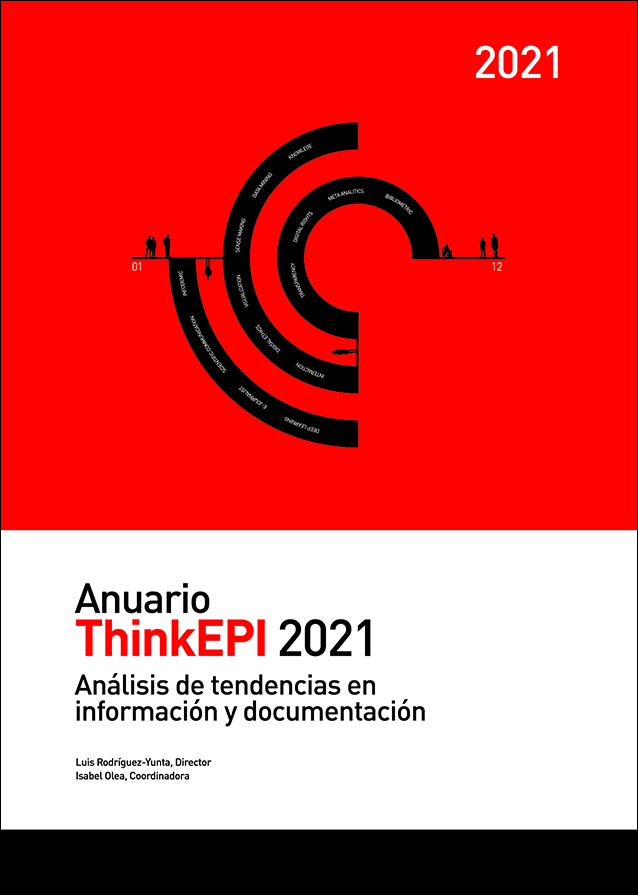Comunicación visual de una emergencia sanitaria mundial: el caso de la Covid-19
DOI:
https://doi.org/10.3145/thinkepi.2021.e15d01Abstract
In the pandemic generated by the coronavirus, governments and the media were suddenly faced with the difficult challenge of communicating about this issue with the population and transferring technical concepts and large volumes of data to the general public. It was necessary to find a way to make this unfamiliar content accessible to everyone, using known and assimilable formulas. In this context, the strategy chosen to make this communication more efficient was clear: transmit all this vital information through the visual representation of data. In this work we analyze the problems associated with the data involved in these visualizations and review a selection of good and bad practices used in these communication strategies.
Downloads
References
Ansede, Manuel; Galocha, Artur; Zafra, Mariano (2020). "ccu cgg cgg gca. Las doce letras que cambiaron el mundo". El país, 11 mayo. https://elpais.com/elpais/2020/05/09/ciencia/1589059080_203445.html
Apple (2020). Informe de movilidad en España durante la pandemia. https://www.apple.com/covid19/mobility
Bowker, Geoffrey C. (2008). Memory practices in the Sciences. Boston: The MIT Press. ISBN: 978 0262524896
Departamento de Seguridad. Gobierno de España (2020). "Coronavirus (Covid-19) - 07 de marzo 2020". Departamento de Seguridad Nacional, 7 marzo. https://www.dsn.gob.es/es/actualidad/sala-prensa/coronavirus-covid-19-07-marzo-2020
Dorling, Danny (2020). "Three charts that show where the coronavirus death rate is heading". Danny Dorling. http://www.dannydorling.org/?p=7758
Financial times (2020). "Coronavirus tracker: the latest figures as countries fight Covid-19 resurgence". Financial times, January 12. https://www.ft.com/content/a2901ce8-5eb7-4633-b89c-cbdf5b386938
Folha de Sao Paulo (2020). https://64.media.tumblr.com/d25c0dfd70fc1b37d18dd21b6bad8c37/57290016272081f1-c3/s1280x1920/7e0a171159a02785ca7f0d3226874f3b65d199aa.png
Google (2020). Informe de movilidad durante la pandemia del Estado de Luisiana. https://www.google.com/covid19/mobility
GOV.UK (2020). Coronavirus (Covid-19) in the UK. https://coronavirus-staging.data.gov.uk
Johns Hopkins University (2020). "Covid-19 dashboard by the Center for Systems Science and Engineering (CSSE) at Johns Hopkins University (JHU)". Coronavirus Resource Center. https://coronavirus.jhu.edu/map.html
Kenta (2020). Twitter. https://twitter.com/kntktnk/status/1246011725293318151
Polack, Fernando P.; Thomas, Stephen J.; Kitchin, Nicholas; Absalon, Judith; Gurtman, Alejandra; Lockhart, Stephen; Perez, John L.; Pérez, Gonzalo; Moreira, Edson D.; Zerbini, Cristiano; Bailey, Ruth; Swanson, Kena A. et al. (2020). "Safety and efficacy of the BNT162b2 mRNA Covid-19 vaccine". The New England journal of medicine, v. 383, pp. 2603-2615. https://doi.org/10.1056/NEJMoa2034577
Reuters (2020). "The Korean clusters". Reuters Graphics, 20 March. https://graphics.reuters.com/CHINA-HEALTH-SOUTHKOREA-CLUSTERS/0100B5G33SB/index.html
RTVE (2020). "Noticias". RTVE. https://www.rtve.es/noticias
Stevens, Harry (2020). "Why outbreaks like coronavirus spread exponentially, and how to "flatten the curve"". Washington Post, March, 14. https://www.washingtonpost.com/graphics/2020/world/corona-simulator/
The New York Times (2020). "An incalculable loss". The New York Times, 27 May. https://www.nytimes.com/interactive/2020/05/24/us/us-coronavirus-deaths-100000.html
The New York Times (2020). "Flattening the Coronavirus curve". The New York Times. https://www.nytimes.com/article/flatten-curve-coronavirus.html
The New York Times (2020). Portada del 24 de mayo de 2020.
Zafra, Mariano; Salas, Javier (2020). "Un salón, un bar y una clase: así contagia el coronavirus en el aire". El país, 28 octubre. https://elpais.com/ciencia/2020-10-24/un-salon-un-bar-y-una-clase-asi-contagia-el-coronavirus-en-el-aire.html
Downloads
Published
How to Cite
Dimensions


